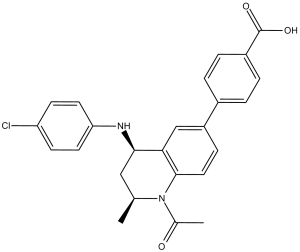GSK1324726A (I-BET-726)
This product is for research use only, not for human use. We do not sell to patients.

For small sizes, please check our retail website as below: www.invivochem.com
| Size | Price | Stock |
|---|---|---|
| 100mg | $580 | In Stock |
| 250mg | $980 | In Stock |
| 500mg | $1470 | In Stock |
Cat #: V0422 CAS #: 1300031-52-0 Purity ≥ 98%
Description: GSK1324726A (I-BET726; GSK-1324726A), a tetrahydroquinoline analog, is a novel and potent ApoA1 up-regulator and selective BET Bromodomain inhibitor with anticancerand anti-inflammatory activity.
Top Publications Citing Invivochem Products
Publications Citing InvivoChem Products
Product Promise

- Physicochemical and Storage Information
- Protocol
- Related Biological Data
- Stock Solution Preparation
- Quality Control Documentation
| Molecular Weight (MW) | 434.91 |
|---|---|
| Molecular Formula | C25H23ClN2O3 |
| CAS No. | 1300031-52-0 |
| Storage | -20℃ for 3 years in powder formr |
| -80℃ for 2 years in solvent | |
| Solubility In Vitro | DMSO: 86 mg/mL (197.7 mM)r |
| Water: <1 mg/mLr | |
| Ethanol: 86 mg/mL (197.7 mM) | |
| SMILES Code | O=C(O)C1=CC=C(C2=CC3=C(N(C(C)=O)[C@@H](C)C[C@H]3NC4=CC=C(Cl)C=C4)C=C2)C=C1 |
| Synonyms | GSK1324726A, I-BET726, I-BET-726, I-BET 726, GSK-1324726A, GSK 1324726A |
| Protocol | In Vitro | A panel of neuroblastoma cell lines are treated with GSK1324726A (I-BET726), and observed potent growth inhibition and cytotoxicity in most cell lines irrespective of MYCN copy number or expression level. All neuroblastoma cell lines tested exhibit potent growth inhibition, with a median growth IC50 value (gIC50; inhibitor concentration resulting in 50% growth inhibition) equal to 75 nM. |
|---|---|---|
| In Vivo | GSK1324726A (I-BET726) inhibits neuroblastoma tumor growth. In the SK-N-AS model, mice in the vehicle group are euthanized on day 14 due to large tumor size. While there is no significant difference in tumor growth between the vehicle and GSK1324726A (5 mg/kg) group, 58% tumor growth inhibition (TGI) is observed in the GSK1324726A (15 mg/kg) group on day 14 of the study (n=9; p=0.006). Mice in the GSK1324726A (15 mg/kg) group are treated for an additional 7 days before tumor volume reaches a level comparable to that observed in the vehicle group, at which point the study is terminated. Tumors in the CHP-212 model grow much more slowly. After 42 days, tumors in vehicle-treated mice are only half the size those in the SK-N-AS model at the end of the study (Day 14). In the CHP-212 model, treatment with 5 mg/kg GSK1324726A results in TGI equal to 50% (n=8; p=0.1816), and mice in the 15 mg/kg group exhibits a TGI of 82% at the end of the study (n=5; p=0.0488). |
These protocols are for reference only. InvivoChem does not
independently validate these methods.
| Solvent volume to be added | Mass (the weight of a compound) | |||
|---|---|---|---|---|
| Mother liquor concentration | 1mg | 5mg | 10mg | 20mg |
| 1mM | 2.2993 mL | 11.4966 mL | 22.9933 mL | 45.9865 mL |
| 5mM | 0.4599 mL | 2.2993 mL | 4.5987 mL | 9.1973 mL |
| 10mM | 0.2299 mL | 1.1497 mL | 2.2993 mL | 4.5987 mL |
| 20mM | 0.1150 mL | 0.5748 mL | 1.1497 mL | 2.2993 mL |
The molarity calculator equation
Mass(g) = Concentration(mol/L) × Volume(L) × Molecular Weight(g/mol)
Mass
=
Concentration
×
Volume
×
Molecular Weight*
The dilution calculator equation
Concentration(start)
×
Volume(start)
=
Concentration(final)
×
Volume(final)
This equation is commonly abbreviated as: C1 V1 = C2 V2
Concentration(start)
C1
×
Volume(start)
V1
=
Concentration(final)
C2
×
Volume(final)
V2
Step One: Enter information below
Dosage mg/kg
Average weight of animals g
Dosing volume per animal µL
Number of animals
Step Two: Enter the in vivo formulation
%DMSO
+
%
+
%Tween 80
+
%ddH2O
Calculation Results:
Working concentration:
mg/ml;
Method for preparing DMSO master liquid:
mg
drug pre-dissolved in
µL
DMSO(Master liquid concentration
mg/mL)
,Please contact us first if the concentration exceeds the DMSO solubility of the batch of drug.
Method for preparing in vivo formulation:
Take
µL
DMSO master liquid, next add
µL
PEG300, mix and clarify, next add
µL
Tween 80,mix and clarify, next add
µL
ddH2O,mix and clarify.
Note:
- (1) Please be sure that the solution is clear before the addition of next solvent. Dissolution methods like vortex, ultrasound or warming and heat may be used to aid dissolving.
- (2) Be sure to add the solvent(s) in order.




































